AC to DC Adapter Cords

Plug these adapter cords into a standard outlet and they change AC voltage to DC voltage. These cords use switching regulation, so they produce the stated voltage even when your outlet’s power or the power drawn by your device fluctuates. It also means they won’t get too hot. They have an LPS low-voltage output and Class II shock protection, so if something fails inside these cords, they’ll limit the risk of electrical shocks. These cords meet U.S. and Canadian safety standards as well as U.S. DOE (Department of Energy) Level VI standards for energy efficiency.
When choosing an adapter, match the output voltage and polarity of your device. Look for the polarity illustration on your device or the adapter you're replacing. The current you choose should, at a minimum, match your device. You can choose a higher current, but it will not improve performance.
Barrel Output Connection | Straight-Blade Input Connection | ||||||||||||
|---|---|---|---|---|---|---|---|---|---|---|---|---|---|
| Voltage | Current, A | End ID, mm | End OD, mm | End Shape | Voltage | Current, A | NEMA Style | End Shape | Lg., ft. | Protections Provided | Specifications Met | Each | |
Negative Polarity | |||||||||||||
| 12V DC | 0.7 | 2.1 | 5.5 | Straight | 120V AC 240V AC | 0.4 | 1-15 | 90° Elbow | 6 | Overvoltage, Short Circuit | UL Listed, C-UL Listed, DOE Level VI Efficiency | 00000000 | 00000 |
| 12V DC | 0.7 | 2.5 | 5.5 | Straight | 120V AC 240V AC | 0.4 | 1-15 | 90° Elbow | 6 | Overvoltage, Short Circuit | UL Listed, C-UL Listed, DOE Level VI Efficiency | 000000000 | 0000 |
| 12V DC | 1 | 2.1 | 5.5 | Straight | 120V AC 240V AC | 0.4 | 1-15 | 90° Elbow | 6 | Overvoltage, Short Circuit | UL Listed, C-UL Listed, DOE Level VI Efficiency | 00000000 | 00000 |
| 12V DC | 1 | 2.5 | 5.5 | Straight | 120V AC 240V AC | 0.4 | 1-15 | 90° Elbow | 6 | Overvoltage, Short Circuit | UL Listed, C-UL Listed, DOE Level VI Efficiency | 000000000 | 00000 |
| 12V DC | 1.5 | 2.1 | 5.5 | Straight | 120V AC 240V AC | 0.5 | 1-15 | 90° Elbow | 6 | Overvoltage, Short Circuit | UL Listed, C-UL Listed, DOE Level VI Efficiency | 000000000 | 00000 |
| 12V DC | 1.5 | 2.5 | 5.5 | Straight | 120V AC 240V AC | 0.5 | 1-15 | 90° Elbow | 6 | Overvoltage, Short Circuit | UL Listed, C-UL Listed, DOE Level VI Efficiency | 000000000 | 00000 |
| 12V DC | 2 | 2.1 | 5.5 | Straight | 120V AC 240V AC | 0.8 | 1-15 | 90° Elbow | 6 | Overvoltage, Short Circuit | UL Listed, C-UL Listed, DOE Level VI Efficiency | 00000000 | 00000 |
| 12V DC | 2 | 2.5 | 5.5 | Straight | 120V AC 240V AC | 0.8 | 1-15 | 90° Elbow | 6 | Overvoltage, Short Circuit | UL Listed, C-UL Listed, DOE Level VI Efficiency | 000000000 | 00000 |
| 12V DC | 3 | 2.1 | 5.5 | Straight | 120V AC 240V AC | 1.3 | 1-15 | 90° Elbow | 6 | Overvoltage, Short Circuit | UL Listed, C-UL Listed, DOE Level VI Efficiency | 000000000 | 00000 |
| 12V DC | 3 | 2.5 | 5.5 | Straight | 120V AC 240V AC | 1.3 | 1-15 | 90° Elbow | 6 | Overvoltage, Short Circuit | UL Listed, C-UL Listed, DOE Level VI Efficiency | 000000000 | 00000 |
Positive Polarity | |||||||||||||
| 12V DC | 0.7 | 2.1 | 5.5 | Straight | 120V AC 240V AC | 0.4 | 1-15 | 90° Elbow | 6 | Overvoltage, Short Circuit | UL Listed, C-UL Listed, DOE Level VI Efficiency | 00000000 | 0000 |
| 12V DC | 0.7 | 2.5 | 5.5 | Straight | 120V AC 240V AC | 0.4 | 1-15 | 90° Elbow | 6 | Overvoltage, Short Circuit | UL Listed, C-UL Listed, DOE Level VI Efficiency | 000000000 | 0000 |
| 12V DC | 1 | 2.1 | 5.5 | Straight | 120V AC 240V AC | 0.4 | 1-15 | 90° Elbow | 6 | Overvoltage, Short Circuit | UL Listed, C-UL Listed, DOE Level VI Efficiency | 00000000 | 00000 |
| 12V DC | 1 | 2.5 | 5.5 | Straight | 120V AC 240V AC | 0.4 | 1-15 | 90° Elbow | 6 | Overvoltage, Short Circuit | UL Listed, C-UL Listed, DOE Level VI Efficiency | 000000000 | 00000 |
| 12V DC | 1.5 | 2.1 | 5.5 | Straight | 120V AC 240V AC | 0.5 | 1-15 | 90° Elbow | 6 | Overvoltage, Short Circuit | UL Listed, C-UL Listed, DOE Level VI Efficiency | 000000000 | 00000 |
| 12V DC | 1.5 | 2.5 | 5.5 | Straight | 120V AC 240V AC | 0.5 | 1-15 | 90° Elbow | 6 | Overvoltage, Short Circuit | UL Listed, C-UL Listed, DOE Level VI Efficiency | 000000000 | 00000 |
| 12V DC | 2 | 2.1 | 5.5 | Straight | 120V AC 240V AC | 0.8 | 1-15 | 90° Elbow | 6 | Overvoltage, Short Circuit | UL Listed, C-UL Listed, DOE Level VI Efficiency | 00000000 | 00000 |
| 12V DC | 2 | 2.5 | 5.5 | Straight | 120V AC 240V AC | 0.8 | 1-15 | 90° Elbow | 6 | Overvoltage, Short Circuit | UL Listed, C-UL Listed, DOE Level VI Efficiency | 000000000 | 00000 |
| 12V DC | 3 | 2.1 | 5.5 | Straight | 120V AC 240V AC | 1.3 | 1-15 | 90° Elbow | 6 | Overvoltage, Short Circuit | UL Listed, C-UL Listed, DOE Level VI Efficiency | 000000000 | 00000 |
| 12V DC | 3 | 2.5 | 5.5 | Straight | 120V AC 240V AC | 1.3 | 1-15 | 90° Elbow | 6 | Overvoltage, Short Circuit | UL Listed, C-UL Listed, DOE Level VI Efficiency | 000000000 | 00000 |
Detachable-Cord AC to DC Adapters







Couple these adapters with a cord that matches your outlet and length requirements to run DC-powered electronics. Instead of plugging directly into an outlet, the body of these adapters sits on the floor or other surface, so it remains out of the way and won’t block multiple outlets. These adapters use switching regulation—they produce the stated voltage even when your outlet’s power or the power drawn by your device fluctuates. Most have an LPS low-voltage output, so if something fails inside these adapters, they’ll limit the risk of electrical shocks. They meet U.S., Canadian, and European safety standards. Many also meet U.S. and European standards for energy efficiency.
When choosing an adapter, match the output voltage and polarity of your device. Look for the polarity illustration on your device or the adapter you're replacing. The current you choose should, at a minimum, match your device. You can choose a higher current, but it will not improve performance.
Adapters with an IEC C8 input require power cords with a C7 socket. With Class II shock protection, they have two levels of insulation that prevent electrical shocks.
Adapters with an IEC C14 input require power cords with a C13 socket. They have Class I shock protection and prevent electrical shocks with a combination of insulation and a protective ground.
Barrel/Pin Output Connection | Straight-Blade Input Connection | |||||||||||||
|---|---|---|---|---|---|---|---|---|---|---|---|---|---|---|
| Voltage | Current, A | Polarity | End ID, mm | End OD, mm | End Shape | Voltage | Current, A | End Shape | Lg., ft. | Shock Protection Class | Protections Provided | Color | Each | |
IEC C8 Input × Barrel Output | ||||||||||||||
| 12V DC | 1.6 | Positive | 2.1 | 5.5 | Straight | 120V AC, 240V AC | 0.48 | Straight | 5 | II | Overcurrent, Overvoltage, Short Circuit | Black | 00000000 | 000000 |
| 12V DC | 3 | Positive | 2.1 | 5.5 | Straight | 120V AC, 240V AC | 1 | Straight | 5 | II | Overcurrent, Overvoltage, Short Circuit | Black | 00000000 | 00000 |
| 12V DC | 5 | Positive | 2.1 | 5.5 | Straight | 120V AC, 240V AC | 1.4 | Straight | 5 | II | Overcurrent, Overvoltage, Short Circuit | Black | 00000000 | 00000 |
IEC C14 Input × Barrel Output | ||||||||||||||
| 12V DC | 1.6 | Positive | 2.1 | 5.5 | Straight | 120V AC, 240V AC | 0.48 | Straight | 5 | I | Overcurrent, Overvoltage, Short Circuit | Black | 00000000 | 00000 |
| 12V DC | 3 | Positive | 2.1 | 5.5 | Straight | 120V AC, 240V AC | 1 | Straight | 5 | I | Overcurrent, Overvoltage, Short Circuit | Black | 00000000 | 00000 |
| 12V DC | 5 | Positive | 2.1 | 5.5 | Straight | 120V AC, 240V AC | 1.4 | Straight | 5 | I | Overcurrent, Overvoltage, Short Circuit | Black | 00000000 | 00000 |
| 12V DC | 7 | Positive | 2.1 | 5.5 | Straight | 120V AC, 240V AC | 1.2 | Straight | 5 | I | Overcurrent, Overvoltage, Short Circuit | Black | 00000000 | 00000 |
IEC C14 Input × 4-Pin Circular DIN Output | ||||||||||||||
| 12V DC | 12.5 | __ | __ | __ | Straight | 120V AC, 240V AC | 2.2 | Straight | 5 | I | Overcurrent, Overvoltage, Short Circuit | Black | 00000000 | 00000 |
| 12V DC | 16 | __ | __ | __ | Straight | 120V AC, 240V AC | 2.8 | Straight | 5 | I | Overcurrent, Overvoltage, Short Circuit | Black | 00000000 | 000000 |
IEC C14 Input × 6-Pin Molex Mini-Fit Output | ||||||||||||||
| 12V DC | 20 | __ | __ | __ | Straight | 120V AC, 240V AC | 3.3 | Straight | 5 | I | Overcurrent, Overvoltage, Short Circuit | Black | 00000000 | 000000 |
| 12V DC | 24 | __ | __ | __ | Straight | 120V AC, 240V AC | 3.9 | Straight | 5 | I | Overcurrent, Overvoltage, Short Circuit | Black | 00000000 | 000000 |
Medical-Grade AC to DC Adapters







To run DC-powered lab and medical equipment from your outlet, add a power cord with the plug style and length you need. These adapters meet strict IEC, UL, or ANSI/AAMI standards for use with medical devices. They also have a Means of Protection rating of 2xMOPP, which is the highest level of shock protection available for medical-grade power supplies, so in addition to using them with lab and medical equipment, you can use them with devices that come into contact with patients.
Unlike adapters with bodies that plug directly into an outlet, the body of these adapters rests on a desk or the floor, so it won’t block multiple outlets. Adapters with an IEC C8 input connection require power cords with a C7 socket. Those with an IEC C14 input connection require power cords with a C13 socket.
When selecting an adapter, make sure the DC voltage and amps for the pin output connection can handle the requirements of your device. Choosing a DC voltage and amps that are much higher than you need will not improve performance.
These adapters use switching regulation, which means they produce the stated voltage despite fluctuations in your outlet’s power and the power being drawn by your device. It also means they won’t get too hot.
If you exceed the maximum voltage or load, these adapters shut down to protect both the adapters and the connected equipment.
All of these adapters meet European safety standards. Adapters with Class II shock protection have two levels of insulation to prevent electrical shocks. Those with Class I shock protection prevent electrical shocks with a combination of insulation and a protective ground.
Barrel/Pin Output Connection | |||||||||||||
|---|---|---|---|---|---|---|---|---|---|---|---|---|---|
| Voltage | Current, A | Polarity | End Shape | Voltage | Current, A | End Shape | Lg., ft. | Shock Protection Class | Protections Provided | Specifications Met | Color | Each | |
Nondetachable-Cord | |||||||||||||
IEC C8 Input × 4-Pole 4-Pin Circular DIN Output | |||||||||||||
| 12V DC | 5 | Positive | Straight | 120V AC, 240V AC | 2 | Straight | 3.4 | I | Overload, Overvoltage, Overtemp, Short Circuit | CE Marked, ANSI/AAMI ES60601-1, UL/CSA/IEC/EN 60601-1 | Black | 0000000 | 000000 |
| 12V DC | 5 | Positive | Straight | 120V AC, 240V AC | 2 | Straight | 3.4 | II | Overload, Overvoltage, Overtemp, Short Circuit | CSA-C22.2 No.60601 3rd edition (2 x MOPP), EN/IEC60601-1, ANSI/AAMI ES60601-1 | Black | 0000000 | 00000 |
| 12V DC | 8.8 | Positive | Straight | 120V AC, 240V AC | 1.3 | Straight | 3.28 | II | Overload, Overvoltage, Overtemp, Short Circuit | CE Marked, 60950-1, IEC/ES/CSA/EN60601-1, IEC/UL/CSA/EN62368-1, IEC60601-1-11 | Black | 0000000 | 000000 |
IEC C14 Input × 4-Pole 4-Pin Circular DIN Output | |||||||||||||
| 12V DC | 13.3 | Positive | Straight | 120V AC, 240V AC | 2.5 | Straight | 3.44 | I | Overvoltage, Short Circuit | CE Marked, UL60601-1, EN60601-1, IEC60601-1 | Black | 0000000 | 000000 |
IEC C14 Input × 6-Pole Molex Mini-Fit Output | |||||||||||||
| 12V DC | 20.8 | Positive | Straight | 120V AC, 240V AC | 1.3 | Straight | 2.62 | I | Overload, Overvoltage, Overtemp, Short Circuit | CE Marked, 60950-1, IEC/ES/CSA/EN60601-1, IEC/UL/CSA/EN62368-1 | Black | 0000000 | 000000 |
IEC C14 Input × 10-Pole Molex Mini-Fit Output | |||||||||||||
| 12V DC | 25 | Positive | Straight | 120V AC, 240V AC | 3 | Straight | 2.62 | I | Overload, Overvoltage, Overtemp, Short Circuit | CE Marked, 60950-1, IEC/ES/CSA/EN60601-1, IEC/UL/CSA/EN62368-1, IEC60601-1-11 | Black | 0000000 | 000000 |
International AC to DC Adapter Cords
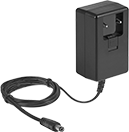
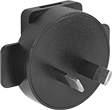
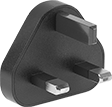

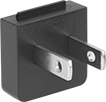
Swap the plug to match the outlet of the region you’re in instead of using separate cords for each country. These adapter cords convert AC voltage to power DC electronics. Designed with switching regulation, they maintain consistent voltage during power fluctuations and don’t get too hot. They meet U.S., Canadian, European, Australian, New Zealand, and Chinese safety standards.
A limited power source (LPS) low-voltage output decreases the risk of electric shock if something fails inside these cords. Class II shock protection means they have two levels of insulation. These cords meet U.S. DOE (Department of Energy) Level VI standards for energy efficiency when they're in-use, as well as when they're plugged in but not in use.
Choose an adapter cord with an output voltage that matches the voltage of your device. The polarity of the adapter cord and your device must also be the same. Look for the polarity illustration on your device or the adapter cord you’re replacing and pick a cord to match.
Barrel Output Connection | Straight-Blade Input Connection | |||||||||||
|---|---|---|---|---|---|---|---|---|---|---|---|---|
| Voltage | Current, A | End ID, mm | End OD, mm | End Shape | Voltage | Current, A | End Shape | Lg., ft. | Protections Provided | Color | Each | |
Negative Polarity | ||||||||||||
AS 3112, BS 1363, CEE 7/16, × NEMA 1-15 Plugs | ||||||||||||
| 12V DC | 2 | 2.1 | 5.5 | Straight | 120V AC, 240V AC | 0.8 | 90° Elbow | 5 | Overvoltage, Short Circuit | Black | 0000000 | 000000 |
| 12V DC | 2 | 2.5 | 5.5 | Straight | 120V AC, 240V AC | 0.8 | 90° Elbow | 5 | Overvoltage, Short Circuit | Black | 0000000 | 00000 |
Positive Polarity | ||||||||||||
AS 3112, BS 1363, CEE 7/16, × NEMA 1-15 Plugs | ||||||||||||
| 12V DC | 2 | 2.1 | 5.5 | Straight | 120V AC, 240V AC | 0.8 | 90° Elbow | 5 | Overvoltage, Short Circuit | Black | 0000000 | 00000 |
| 12V DC | 2 | 2.5 | 5.5 | Straight | 120V AC, 240V AC | 0.8 | 90° Elbow | 5 | Overvoltage, Short Circuit | Black | 0000000 | 00000 |
DC to AC Adapter Cords

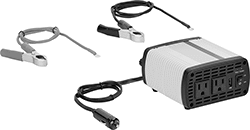

Plug these cords into a vehicle socket to charge devices that run on AC voltage. Also known as inverters or converters, they prevent damage from overloads.
Vehicle Connection | Straight-Blade Connection | USB Connection | Body | Color | ||||||||||||||
|---|---|---|---|---|---|---|---|---|---|---|---|---|---|---|---|---|---|---|
| Total No. of Outlets | Voltage | End Shape | NEMA Style | Voltage | Wattage | End Shape | Current, A | Type (No. of Ports) | End Shape | Lg., ft. | Ht. | Wd. | Dp. | Includes | Body | Cord | Each | |
| 1 | 12V DC | Straight | 5-15 | 120V AC | 150W | Straight | __ | __ | __ | 3 1/2 | 1 3/4" | 3 3/4" | 5 3/4" | __ | Red | Black | 0000000 | 000000 |
| 2 | 12V DC | Straight | 5-15 | 120V AC | 425W | Straight | 2.1 | A (1) | Straight | 2 | 2 5/8" | 5" | 6 1/2" | Battery Cable with Alligator Clips | Yellow/White | Yellow | 0000000 | 00000 |
| 2 | 12V DC | Straight | 5-15 | 120V AC | 400W | Straight | 2.4 3 | A (1) C (1) | Straight | 3 | 2 1/2" | 5 3/4" | 7" | Battery Cable with Alligator Clips | Black/Yelow | Black | 0000000 | 00000 |



























